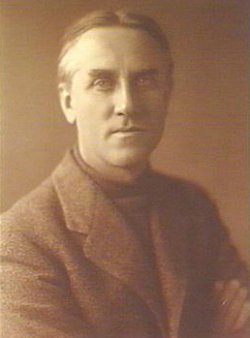Hans Heysen
Wilhelm Ernst Hans Franz Heysen was born in Hamburg on
8 Oct 1877 the 6th child of Louis Heinrich Wilhelm Heysen
and his wife Maria Elisabeth Henriette, née Eberhard.
At the age of 6 he emigrated with his family to South Australia.
His father had gone ahead the previous year (1883) to make
appropriate preparations for his family.
 Heysen
left school in 1892, working first in a hardware store and
then on one of his father's carts. At 14 he bought his first
paints: I saw a drainpipe with stalks and reeds …
It seemed to me beautiful so I painted it, he said.He
enrolled at James Ashton's Norwood Art School and by the
age of 16 was painting so well that Ashton bought a watercolour
entitled, The Wet Road now at the Art Gallery of
South Australia. Heysen
left school in 1892, working first in a hardware store and
then on one of his father's carts. At 14 he bought his first
paints: I saw a drainpipe with stalks and reeds …
It seemed to me beautiful so I painted it, he said.He
enrolled at James Ashton's Norwood Art School and by the
age of 16 was painting so well that Ashton bought a watercolour
entitled, The Wet Road now at the Art Gallery of
South Australia.
Heysen quickly attracted wealthy patrons including Robert
Barr Smith who paid tuition fees at the school of design
at the Art Gallery of South Australia under Harry Gill.
In 1899 four men offered Heysen a contract in which they
agreed to advance £400 to finance his studies in Europe
in return for the right to recoup their outlay by selling
whatever he might paint while overseas.
He married Selma Bartels 15 Dec 1904
By 1912 he had earned enough to purchase a property, the
Cedars at Handorf where he remained for the rest
of his life painting local vistas and in particular the
gum trees of the district.
Heysen holds a place in the history of Australian landscape
art. He won the Wynne prize nine times between 1904 and
1932, the Crouch prize in 1931, and the Maude Vizard-Wholohan
prize in 1957. He was knighted in 1959.
Heysen fought to preserve the flora of the Adelaide Hills.
He died at Mount Barker 2 Jul 1968. He is remembered within
SA with the Heysen Range in the Flinders, the Heysen Trail
- a walking trail from Cape Jervis to Parachilna Gorge,
the Heysen Tunnels on the Hills Freeway and the Heysen Electorate.
|